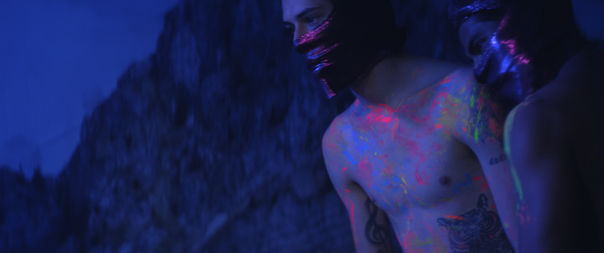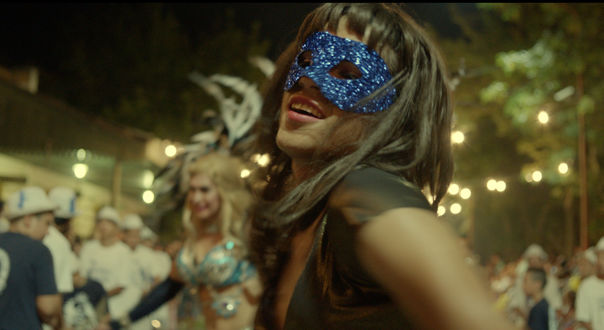It’s Political to Love Yourself
By Kennith Rosario

© Avante Filmes
In a dimly lit room, Pedro’s body is barely visible. Especially when captured by the grainy image of a webcam. But as he pops open a bottle of bright paint and seductively applies it over his naked body, the colours leap out of the screen and so does Neon Boy, Pedro’s online persona.
Vibrant colours have had a close association with diverse queer identities, as is evident in the rainbow flag of the LGBTQ community. In HARD PAINT (TINTA BRUTA, BRAZIL), co-directors Marcio Reolon and Filipe Matzembacher use this fundamental symbolism of queerness to portray both the liberation and control of one’s body. In several queer films at the 68th Berlin International Film Festival, the human body is used as a tool for activism — by explicitly exhibiting its non-conformist, multifaceted nature.
HARD PAINT begins with Pedro being tried in a courtroom, but refrains from revealing the charges levied upon him. It appears that he is involved in a traumatic case of violence. As he walks on the street, he is met with stares from people. “You don’t know if they are staring at Pedro because he has committed a crime or because he is gay,” shares Reolon in an interview with the writer.
The scene could allude to the criminalisation of same-sex relationships in 72 countries and territories worldwide (according to a 2017 report in “The Guardian”). Several countries like India (where the Supreme Court recriminalised same-sex activities in 2013) and Bermuda (which became the first jurisdiction in the world to reverse a law allowing same-sex marriage in 2018) are backtracking on rights previously granted to the queer community. Reolon and Matzembacher observe that this seemingly global trend can be felt sharply in Brazil alongside an unprecedented rise in political conservatism. Against this backdrop of rising homophobia, queer films like HARD PAINT are projecting more evocative images; ones that are more explicit and have a sharper focus on the naked body and queer sex. These images, in a way, push the boundaries of the heteronormative gaze to fully educate the cis-world about the hidden chambers of queer culture. One could argue that the intention is to showcase every aspect of the queer world, so ignorance won’t become a reason for renewed backlash.
Body politics and resistance have been the dominant themes at the Panorama section of the Berlinale this year. Encouraging LGBTQ narratives is not new to the festival. Panorama has been running the Teddy Awards for queer films for the last 32 years. Last year’s Competition entry and now Oscar-nominated Chilean drama, A FANTASTIC WOMAN (UNA MUJER FANTÁSTICA), about a transgender woman mourning the death of her partner, won the Teddy last year for best feature film and the Silver Bear for best screenplay.
Recent stories of trans people, at least in the popular American cinema, have focused on the misery of a pre-transitioned body and the soul trapped within it. Case in point: DALLAS BUYERS CLUB (2013) and THE DANISH GIRL (2015). But in two films at this year’s Berlinale — TRANNY FAG (BIXA TRAVESTY, Brazil) and OBSCURO BARROCO (France, Greece) — transgender activists and artists of colour who have transitioned use their transformed bodies as political statements against machismo.

Filmmaker Evangelia Kranioti in OBSCURO BARROCO highlights transgender activist Luana Muniz’s body using shots that allow details to emerge. There’s ample soft, flattering light and close-ups of Muniz’s long eyelashes, painted nails, brown skin and enlarged breasts. The filmmaker doesn’t flinch from capturing the genitalia of a transvestite performer as she strips on-stage, showcasing her dual state of being: a man and a woman.
“It’s political to love oneself,” says Linn da Quebrada, a pop performer who raises her voice in support of effeminate queer men and transwomen. In BIXA TRAVESTY, Quebrada’s body is fully in her control as she delivers an unrestrained performance on-stage while calling herself a woman with a penis. “When people look at me and yell ‘faggot!’, I think, am I disguising myself? Do I need your reminder?” she says. Co-directors Claudia Priscilla and Kiko Goifman supplement Quebrada’s transsexuality with intimate images of complete nudity, tearing deep into the binaries of the human body. The camera captures her inserting a lipstick tube into her foreskin, leaving a bright red streak on her brown skin, depicting the juxtaposition between ultimate manliness (the penis) and traditional femininity (make-up).
In HARD PAINT, Pedro is often seen wearing clothes that are shorter than his frame. It’s not that he is a large man. He is, in fact, as one would call in queer slang, an archetypal “twink”. According to Reolon, the protagonist’s clothes are emblematic of him outgrowing his heteronormativity. Pedro is not a cross dresser, but the subtle sartorial detail is an indication of a hidden self, which is most visible in a chat room when he is covered in neon.
Alienation and oppression are at the core of queer activism; two aspects that resonate with all underprivileged minority groups. It’s this universality that has driven queer films to embrace intersectionality. “We want those outside the normative – black, poor or ethnic – to be a part of our story,” says Reolon, co-director of HARD PAINT. Martín Rodríguez Redondo’s MARILYN, for instance, is an antithesis of the capitalist representation of the queer culture in popular media. The film is set in rural Argentina, where a conservative, lower-income family leaves no room for a young man, Marcos, to explore his sexual identity. “Our idea was to show that the society fences in the family, and in turn the boy’s mother fences in her son,” says Redondo, in an interaction after a screening at Berlinale. Marcos is never uncomfortable with his homosexuality but is frustrated at having to contain it. MARILYN, therefore, is a coming-of-age film which skips the process of coming to terms with yourself and instead focuses on the question: what comes after being comfortable with homosexuality?
It’s a question that haunts Pedro in HARD PAINT as well. Trapped in the confines of the working class, he resorts to chat room performances for money, which unexpectedly, helps him develop his sexual identity. Both Reolon and Matzembacher have been deeply involved in queer activism apart from being filmmakers. It’s quite inevitable therefore to talk about HARD PAINT without addressing the polity surrounding the narrative. Pedro, for instance, enters into a relationship with a black gay man. With a tiny, ethnic queer population in Brazil, the involvement of a black actor, Bruno Fernandes, was imperative for the filmmakers. “It’s important to see the film through colour, class and race,” says Fernandes. “If you’re black, fat or ugly, you will face added phobia, even within the gay community.”
OBSCURO BARROCO, on the other hand, blends trans visibility with anti-government protests in Brazil. Through a series of contradictory images (like the intimate spaces of Muniz and impudent performances by trans performers), Kranioti depicts that the city is no different from Muniz: they’re both in a state of constant transition and unafraid to express themselves. For Muniz, the human body is a prop: a costume at a perpetual carnival. What better to illustrate that than capture the lifelessness of papier-mâché idols and cardboard faces, covered in colour and glitter, that lie unused after the protests are done?
Ultimately, BIXA TRAVESTY depicts the ephemerality of the human body as it enters a hospital room where Quebrada is being treated for cancer. She is stripped of all adornment as she lies in a state of jeopardy. The feisty activist is shown to be at her most vulnerable when she could possibly lose the most effective tool of her activism – her body. But in her perseverance and fight against cancer, BIXA TRAVESTY shows that the best activism is a life lived with unrelenting authenticity.

